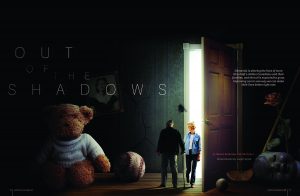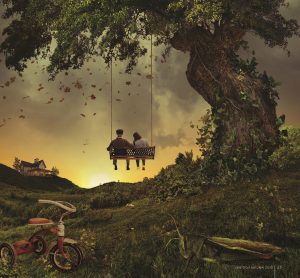Dissecting award-winning higher ed communications
By Sharon Aschaiek | July 24, 2019

What does effective storytelling look like in higher ed communications? For a prime example, look to the University of Alberta in Canada.
The university won a 2019 Platinum Award from the Council for Advancement and Support of Education (CASE) for Best Article of the Year for Out of the Shadows, which published in the Autumn 2018 edition of its alumni association magazine, New Trail. The long-form article covers multiple dynamics of dementia: the challenges it poses for sufferers and their families; innovative and emerging treatment approaches; and the current state of dementia research.
Winning elements
The article, which is written by U of A alum Bruce Grierson, succeeds for a number of reasons:
Relevant topic: Dementia is a prevalent condition worldwide, one that has a devastating impact on families, and that is still largely an inscrutable riddle. Most of us have stories of witnessing loved ones or friends grapple with this memory-snatching, cognition-debilitating syndrome, and of experiencing the frustration of feeling unable to help them. With 50 million people affected worldwide, and nearly 10 million new cases arising every year, dementia is a topic that feels urgent.
Skillful writing: Bruce Grierson has excelled at weaving together the findings and insights of researchers from U of A and elsewhere together with his own personal story about his mother’s Alzheimer’s. He makes the dense or complicated medical information accessible. He uses catchy turns of phrase and expressions to make the story interesting. Vivid details, personal anecdotes and impactful quotes also add colour. The editor of New Trail was wise to hire Grierson, a widely published, five-time Canadian National Magazine Award-winning feature writer as well as an author.
Compelling design: This article includes surreal and captivating art by Canadian Juno Award-winning graphic artist Hugh Syme. The images are realistic-looking colour paintings of scenes that suggest the landscape of the mind, with objects scattered about in the dark corners of our memories, human connection and being present. The art helps bring home the writer’s overriding message: “We are not our memories. Even though it sometimes feels that way.”

Diverse format: This eight-page article package features a range of elements that create different points of interest on the same topic. In addition to the main long-form feature story, it includes a second, shorter story specifically about the different theories being explored and studies being pursued in Alzheimer’s research. It also includes two fact boxes that explain relevant medical terminology, and an infographic on key dementia statistics.
Hope: While dementia can be a difficult and painful topic, this story is told in a way that suggests a light at the end of the tunnel. It begins by placing the reader in De Hogeweyk, a gated model village near Amsterdam that has been designed specifically as a care facility for elderly people with dementia. The village simulates “normal life” for residents and includes personalized activities and interactions with local townspeople—who are actually geriatric nurses and caregivers—that appeal to residents’ interests and strengths. We also learn about the “butterfly” model of long-term care—which emphasizes fostering positive emotions in residents—and about the intrepid and dedicated researchers investigating innovative interventions.
The power of story
As this story demonstrates, strong storytelling is a very powerful way for a university or college to reflect its good work—in this case, the efforts of its faculty members to research and make a difference in an area of health care that profoundly affects us all. An interesting topic combined with expert writing, design, editing and layout skills can go a long way in helping your institution engage with target audiences and raise its profile.